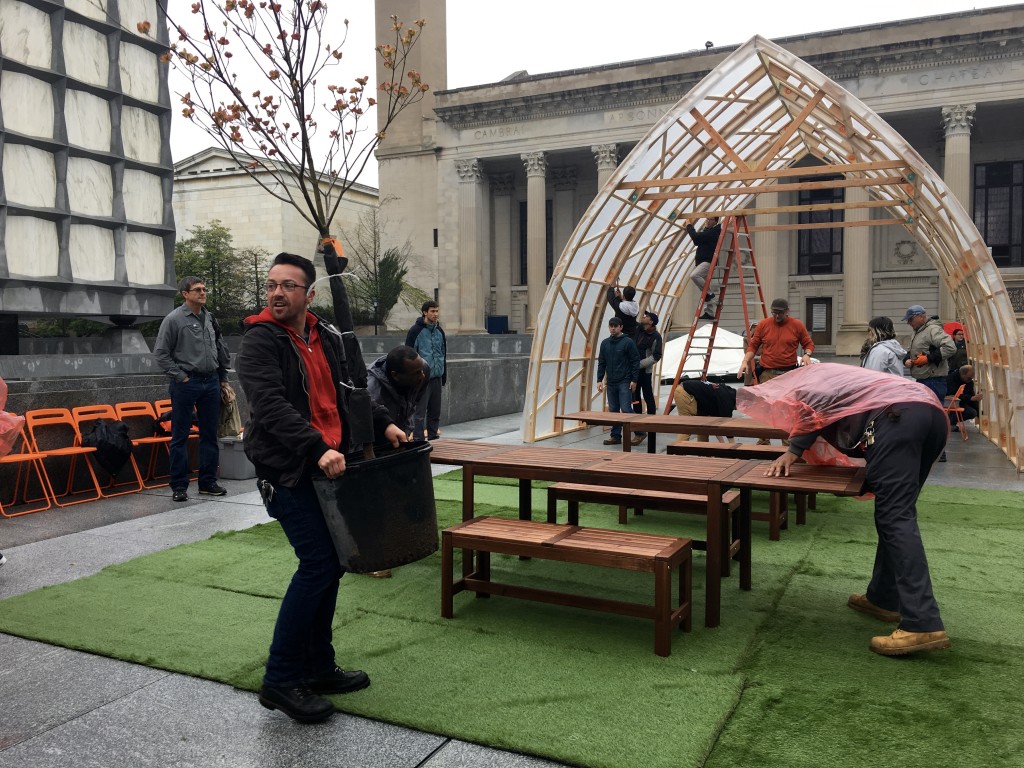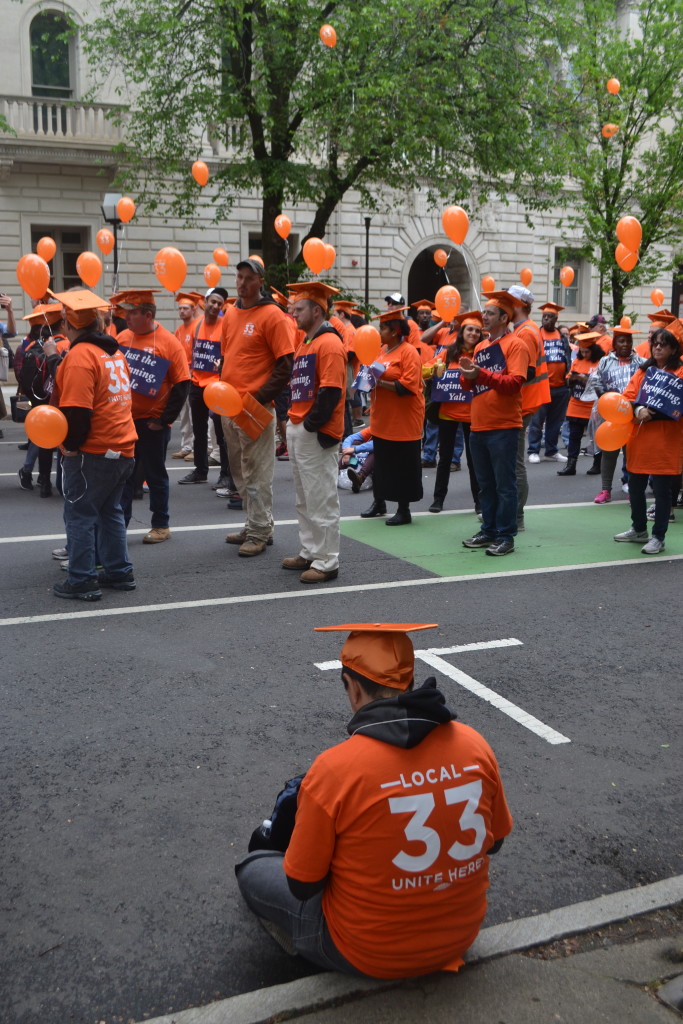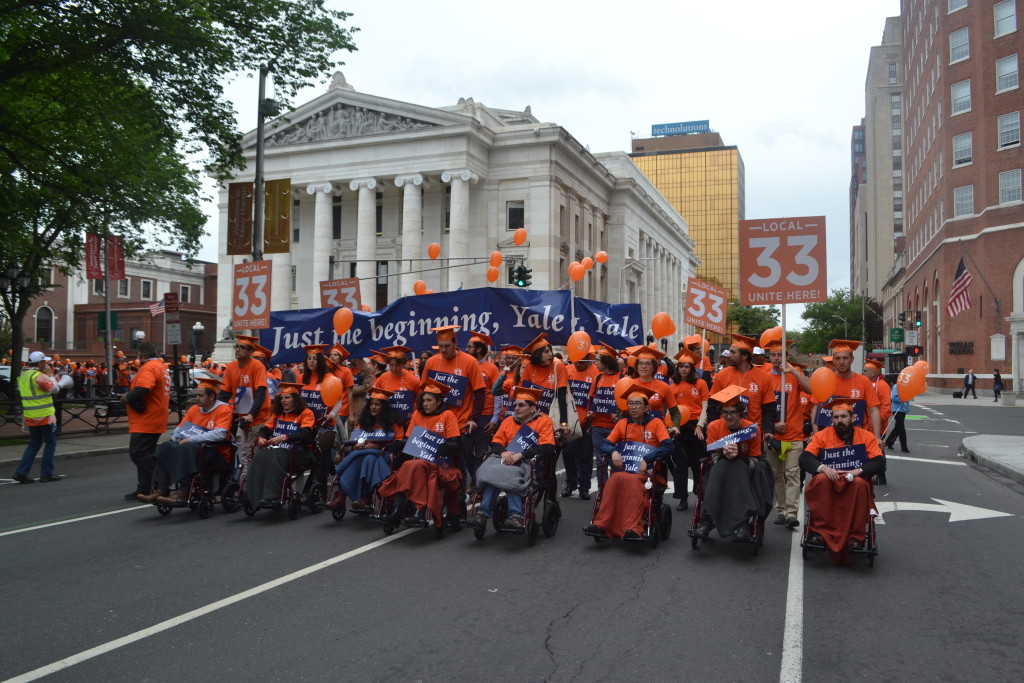As a light rain fell on New Haven, hundreds of teachers, students, and labor organizers walked in silence down College Street. The April 25 march, which had the gravity of a funeral procession, began outside the Methodist Church across from Battell Chapel and ended at a white tent erected in front of Yale University President Peter Salovey’s house on Hillhouse Avenue. Rising to address the crowd on a makeshift stage, Maria Elena Durazo, the Democratic National Committee Vice Chair, drew parallels between graduate student teachers’ recent efforts to unionize and social justice movements of the past. “It is always this way,” she said. “When you seek what you deserve, when you act to make your rights real, you’re ignored at first.”
For months, Local 33, the Yale graduate student teacher’s union, had been calling upon the Yale administration to begin negotiating their first contract, a legal agreement between the union and the University about working conditions and employee benefits. In February, when graduate student teachers voted to unionize on a department-by-department basis, the mood among Local 33 organizers had been jubilant. But Yale had repeatedly refused to officially recognize the union, and by April, organizers decided it was time to raise the stakes.
“It is always this way. When you seek what you deserve, when you act to make your rights real, you’re ignored at first.”
Toward the end of her remarks, Durazo turned to the eight graduate student teachers gathered around her in a semicircle. “Yale wants you to wait…and so you will wait, without eating. You will show Yale that you have power.” She pivoted back to the crowd and announced what they had all been waiting for: “Tonight, eight courageous members of Local 33 begin a fast.”
Those eight members would subsist on water alone in “The Fast Against Slow,” an attempt to draw nation-wide attention to their cause. If a faster’s health faltered, an allied graduate teacher would take her place—an indefinite system of rotation. The fasters had deeply personal reasons for joining the demonstration. Julia Powers, a Comparative Literature graduate student teacher, told the crowd that she was “tired of widespread and unchecked sexual harassment at Yale.” Generations of “brilliant, talented women” — including some of her acquaintances, Powers said — had their careers derailed because “men with long and well-known track records of harassment” oversaw their work. Tif Shen, a Mathematics graduate student teacher, said that when he reported an incident of assault and harassment in the workplace, the administration ignored him. Emily Sessions, from the History of Art department, said that when she spoke up about working conditions in her department, she was called a liar, threatened, and told to “shut up.”
“Fixing this takes will, not time, and I’m tired of being powerless while Yale blossoms,” Sessions told the crowd. “Yale has to respect us and listen to us, not wait longer. But Yale has told us to wait, so I am waiting, without eating.”
—
The sudden visibility of Local 33’s efforts this past spring took many undergraduates by surprise. Most weren’t entirely sure of what to make of “33 Wall Street,” a 25-foot bowshed that members of Local 33 erected on Beinecke Plaza the morning after the Hillhouse Avenue march. The plastic-and-wood shelter stood for four weeks, staffed by round-the-clock shifts of supporters who gathered at picnic tables and under strings of lights. The encampment was impossible to miss and prompted passersby to confront the University’s relationship to labor — something many had never done before.

But despite the seeming novelty of the demonstration, Local 33’s actions fit into a narrative of union organizing that is integral to the last half-century of Yale’s history. By the mid-1980s, Yale’s clerical and technical workers had formed Local 34, and its dining hall, custodial, and maintenance workers, who began organizing in the 1930s, had formed Local 35. Both unions currently exist under the international labor union UNITE HERE, which represents thousands of workers across North America, from hotel employees to railroad dining car workers. Motivated by rising job insecurity and the increasing cost of living in New Haven, graduate student teachers also started organizing in the late 1980s, first through a group called T.A. Solidarity, which later became the Graduate Employees and Students Organization (GESO) and, as of last year, Local 33. As each iteration of the group emerged, the Yale administration fought back, repeatedly thwarting their attempts to unionize.
For the past three decades, the conflict between graduate student teachers and the University has centered on one central distinction: Are they employees, deserving of benefits similar to University professors? Or are they students, bestowed with University resources like undergrads, and tasked with extra responsibilities that reflect their academic training?
Are they employees, deserving of benefits similar to University professors? Or are they students, bestowed with University resources like undergrads, and tasked with extra responsibilities that reflect their academic training?
The graduate student teachers who began early organizing efforts in the late 1980s were fighting for not just for certain workplace conditions and benefits, but for a specific ideological framework: we are students and employees. It was an issue that had never come up for Yale’s dining hall or clerical workers, who were undoubtedly University employees.
Doctoral students at Yale receive a full tuition waiver for five years of study, as well as teaching stipends, which vary from student to student. But for many graduate student teachers, that stipend, which is $30,250 a year at minimum — more than seven thousand dollars less than New Haven’s median household income — is not an adequate living wage.
For decades, the Yale administration has cleaved to one position: graduate student teachers are students, first and foremost. In the late 1980s and early 1990s, Yale administrators were frequently quoted in the national media arguing that pro-union graduate student teachers had misunderstood their role at the University. “Forming a union represents an incorrect understanding of what teaching assignments for graduate students really are,” Donald Kagan, then-dean of Yale College, told The New York Times in 1991. “They were never intended to be jobs, but rather to be teaching apprenticeships.”
Michael Denning, a professor of American Studies who has been involved with unionization efforts since he was a graduate student teacher at Yale, has never thought much of this line of argument. “If these were really students,” he said, “why would [the University] give them grants? It’s because they’re not students. The whole issue of the tuition waiver, to me, has always been an indication that they aren’t really students…That’s just a pure ideological illusion.”
After years of demonstrations and debates that resulted in minimal progress, the graduate student teachers’ labor movement gained sudden momentum in August 2016, when the National Labor Relations Board ruled in favor of Columbia University’s graduate student teachers. The decision deemed them not only students but also employees entitled to collective bargaining rights under federal law. It provided the legal precedent for the battle that Yale’s graduate student teachers had been fighting for the past 25 years.
But for Yale administrators, the ruling was not the final word. Shortly after the February elections, lawyers working on behalf of the University filed a “request for review” with the NLRB in Washington, D.C. The University wanted a reevaluation of Local 33’s “unprecedented” micro-bargaining strategy, which had been debated before the National Labor Relations Board in October 2016. Until the request for review was resolved, Yale would refrain from negotiations with the newly-certified union.
—
Over the past three decades, Yale and its unions have maintained a fragile, often acrimonious, relationship. In a March 2003 article in The New York Times, Steven Greenhouse, a labor journalist, called it “unusually rancorous.” Until 2003, strikes and walkouts occurred almost every three years, as each contract developed through bitter negotiations.
Janet Lindner, Yale’s vice president for human resources and administration, wrote in an email this summer that since 2003, there has been “a generation of strong partnerships based on the hard work of union and management leadership.” Union leaders and University administrators have collaborated on goals and worked toward a sense of mutual trust, she said, adding, “Many employees at Yale now have never experienced a strike, and that gives me great hope for the future.”
But this past spring, Local 33’s demonstrations seemed to belie any indication that the University and its unions were on good terms. At best, the protests recalled the bitter labor conflicts that have defined the University’s past.
“What is Yale afraid of?” members of Local 33 asked at rallies, just as in September 1984, Local 34 strikers demanded, “Why should the Yale administration hide from the truth?”
The striking clerical and technical workers were in the midst of their first contract negotiations in the fall of 1984. They called for salary increases, expanded benefits, and job security over the next three years. Dining halls closed as their workers, members of Local 35, joined the picket lines. Local 34 accused the University of discrimination on the basis of both race and gender; the union primarily consisted of the female support staff that populated the University’s reception rooms and front desks.
When labor disputes dominated campus, undergrads were forced to reckon with their own dilemmas, both moral and practical, in ways that are unfamiliar to the vast majority of students today.
The strike ended after ten weeks, although protests and demonstrations continued through the winter. When the University and the union finally struck a deal in January, Local 34’s victory was apparent. But it came with a price: a semester’s worth of lost wages and job uncertainty.
During the strike, there was an abiding sense among union members that Yale didn’t treat its workers with respect, said John Wilkenson, who was the secretary of the University at the time. “You shouldn’t tighten your belt in a way that will discourage or demoralize your employees, because it comes back and bites you,” he reflected. “You lose in the long run.”
When labor disputes dominated campus, undergrads were forced to reckon with their own dilemmas, both moral and practical, in ways that are unfamiliar to the vast majority of students today. Do I cross a picket line, or do I skip my class? Do I work my student job, or do I refuse in solidarity with the striking workers?
Despite the outpouring of public support in 1984, student opinion was split. A Yale Daily News poll taken soon after the strike began found that twenty-one percent of students supported the University, thirty-five percent of students supported Local 34, and thirty-nine percent disagreed with both sides. Of those who disagreed with both sides, one third chose the option, “I care but I’m confused.”
—
Still, with its 80 percent female membership, Local 34 expanded people’s understanding of what a union member could look like and what unionization could achieve. Soon, graduate student teachers began to define themselves as workers with rights. The conceptual gap between an academic worker and an clerical worker was far narrower than the gap between an academic worker and, say, a factory worker. Additionally, many graduate student teachers were married to members of Local 34, exposing them to regular union activity, Wilkenson said.
Practical concerns accompanied conceptual ones. In the 1980s, the teaching demands placed on graduate student teachers were growing increasingly intense. Graduate student teachers were asked to spend more time teaching undergrads than ever before. Financial strains were mounting: by the end of the decade, a graduate student teacher’s teaching salary was many thousand dollars less than the cost of living in New Haven.
Financial strains were mounting: by the end of the decade, a graduate student teacher’s teaching salary was many thousand dollars less than the cost of living in New Haven.
In 1987, a group of graduate student teachers calling themselves “T.A. Solidarity” — the precursor to GESO and Local 33 — held its first official meeting to discuss formal recourse for improving their working conditions. The organizers grappled with how to define their new group in relation to the unions that already existed on campus. As graduate student teacher Christopher Lowe jotted down on a legal pad during an early meeting, how could they maintain their autonomy as a graduate student teachers’ “advocacy group” while avoiding becoming a “union support group”? On the other hand, how could they learn from “the experience of the unions… about how Yale might behave?” As the graduate student teachers broached the question of tactics — to strike or not to strike? to withhold grades or to give everyone an “A”? — they balanced their own interests against public opinion and their allies’ positions. Lowe believed that a close alliance with the unions would help further both causes, and it was the position that the group’s organizers ultimately adopted.
T.A. Solidarity’s evolution into GESO in 1990 marked the graduate student teachers’ first distinctive move toward a union-style advocacy group. Like a union, GESO went on strikes, petitioned the NLRB, and organized across departments. And in March 2016, GESO rebranded itself as “Local 33,” clearly signaling its allegiance to the union model.
But the legal argument against graduate student teachers as workers held strong, as it had for years. Since 1970, cases regarding graduate teacher unionization at private universities had flooded the courts. In 1972, a ruling involving Adelphi University determined that graduate student teachers were “primarily” students, not employees. The pendulum swung back and forth over the next few decades, as decisions were reversed and reinstated, defining and redefining the nature of graduate student teacher work.
—
With the Columbia University decision in 2016, the NLRB set a new precedent, arguing that graduate student teachers are legal employees. Local 33 organizers wasted little time to catch the momentum of fresh empowerment and launched into a new strategy for negotiating with the University: they would organize department by department.
This strategy would secure collective bargaining units through individual departments — English, Geology and Geophysics, History, History of Art, Math, and Sociology — rather than through an all-department vote. Each of those six departments that voted to unionize would draw up a separate contract with the University. It was a tactic that ultimately included only a small proportion of the overall graduate student teacher body. But from Local 33’s perspective, they had achieved their union; they were NLRB-certified.
“The logic of it makes sense, because people are doing very specific kinds of labors in very particular units,” said Jennifer Klein, a professor of labor history at Yale who supports and works with Local 33. “[White collar unions] are organizing through a different form of unionism than industrial unionism.” This “micro-bargaining” strategy made sense for Local 33 because of the highly-specialized nature of graduate-level work, she said, and because it was a more feasible organizing strategy for a place like Yale, where organizers expected considerable pushback.

There was also some precedent for Local 33’s micro-bargaining tactic. In a 1996 academic journal article on the history of unionization at Yale, John Wilhelm, then-president of UNITE HERE, wrote that in the 1930s and 1940s, the custodial, maintenance, and dining hall workers organized “incrementally,” group-by-group, before banding into one union, Local 35. Their unionization process took over a decade.
But the University declined Local 33’s invitation to begin collective bargaining in eight departments. “Yale respectfully notes that this request is premature because the legal questions raised by Local 33’s unprecedented ‘micro-unit’ strategy remain unanswered,” an April 11 statement read. “Yale is still engaged with Local 33 before the NLRB. The university respects the legal process for resolving labor issues while this case continues to move forward.”
Many students also questioned the validity of Local 33’s methods. Stephen Krastanov, a graduate student teacher in Physics involved with GASO, a group of graduate students teachers opposed to Local 33, said that for him, the union, not the University, was bargaining in bad faith. “They are waiting for a union before they start thinking about how they will be using that union,” he said. Krastanov also believes that Local 33 also has a tendency to misrepresent facts: “They are setting up the University to look bad without honestly trying to negotiate with them.”
As 33 Wall Street stood on Beineicke Plaza, conversations on Cross Campus and in the comment threads of the “Overheard at Yale” Facebook page revealed the ambivalence over Local 33’s tactics that pervaded the student body. Why was so much of the graduate student teacher body excluded from the vote, as the University claimed? Were the elections really democratic?
Why was so much of the graduate student teacher body excluded from the vote, as the University claimed? Were the elections really democratic?
This spring wasn’t the first time Local 33 had come under fire from the University community for its organizing tactics. On January 15, 2016, a group of “women, LGBTQ graduate students, and graduate students of color” penned an open letter to the leadership of GESO, which would become Local 33 two months later. “Tactics targeting students outside of their classrooms, in their offices, their apartments and dorm rooms are invasive regardless of how we move through the university,” wrote the undersigners, many of them union members and organizers who “write with a shared recognition of the powerful work this union has done over the last two decades to support marginalized university employees and New Haven residents.”
Over the past year, Local 33 has tried to improve upon the tactics described in that letter. “We make mistakes, but we also do the very best we can,” said Julia Powers, one of the first fasting graduate student teachers, in a phone call over the summer. Melis Laebens, another graduate student teacher, said that although Local 33 is not perfect, she’s been “mostly sympathetic” to their position in the past year. “I have had personal tensions with my organizers at some points, and got angered a couple of times, but I have currently found my organizers are willing to listen and accommodate.” Her support, however, is “not unconditional.”
The University’s own delay tactics are similarly contested. Union detractors, including a sizeable portion of graduate student teachers, say Yale is a working within the bounds of the law; union supporters, including thirteen members of the Yale Law School who issued an open letter to the administration, believe that the University is actively defying labor law.
In the purview of the past twenty years of labor history, the current situation could best be described as “business as usual.” Some legacies, it seems, are harder to shake than others.
—
On the morning of last year’s Commencement Day, 33 Wall Street was unusually empty; the action was elsewhere. About five blocks away, in UNITE HERE’s downtown offices, local labor activists were preparing for a protest march that had brought hundreds of union supporters from across the East Coast to New Haven. Auto workers, fast food workers, union families, and graduate student teachers from other universities congregated on streets around the New Haven Green. “Union power in the ivory tower!” they chanted, sporting orange t-shirts and mortar boards.
In the weeks leading up to commencement, graduating seniors and the University administration had voiced concerns that the protesters would disrupt the ceremonies by seizing the stage or blocking the path of the formal procession. But the action was orderly and celebratory.

The demonstration halted on the corner of Elm and College Streets, where the marchers faced the graduating class of 2017. Behind a line of police motorcycles, the final group of Local 33’s fasters sat in wheelchairs, in front of a crowd of cheering union supporters and a blue banner that proclaimed, “Just the beginning, Yale.” The protesters cheered on the graduating seniors; some students shouted back words of support.
The Local 33 marchers seemed proud and defiant, but in many ways, it wasn’t their day to celebrate. When the formal procession was over, the protesters continued their march to City Hall. There, the eight remaining hunger strikers broke their fast, drinking cups of warm butternut soup. They huddled underneath a white tent as a light drizzle fell on downtown New Haven. They were in good spirits, but weary. In a few days, campus would empty out for the summer. The fight was far from won.
The Local 33 marchers seemed proud and defiant, but in many ways, it wasn’t their day to celebrate.
Yale, for its part, had already begun its counter-attack. On Commencement Day, volunteers distributed water bottles and palm-sized pamphlets along the procession’s path. The pamphlet, entitled “Information on Graduate Student Unionization,” was a preventative measure. It contained a two-part argument that the graduate student teachers had seen before: one, graduate student teachers at Yale were organizing undemocratically; two, graduate student teachers at Yale were among the most privileged in the country.
The material structures that had defined Local 33 during its stint of campus prominence were also quietly removed. At dawn on May 25, a crew of non-union maintenance workers dismantled 33 Wall Street. The following weekend, when alumni descended upon campus for college reunions, no sign of union activity was in sight.
The summer’s peace didn’t last long, however. On August 25, as first-years arrived on campus, a curious structure appeared on the New Haven Green. The bowshed was smaller and entirely orange this time, but similarly handsome. As Yale’s newest class swarmed Old Campus, members of Local 33 stood in front of the cleverly-named “33 College Street,” exchanging smiles and handing out fliers to first-years and their families.
In his 1996 article about the history of unionization at Yale, John Wilhelm, then-president of UNITE HERE, reflected on labor struggles new and old. “It’ll take a while, but I think all of us will get over the discouragement and taste a little bit of the joy and the freedom and the power of that kind of struggle,” he said. “Some of us have had the privilege to go through it before.” The legacy of past labor struggles may be hard to shake, but not for a lack of trying.


